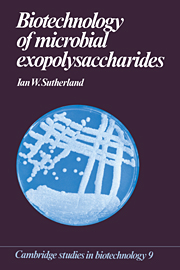Book contents
- Frontmatter
- Contents
- Preface
- 1 Introduction and definition
- 2 Polysaccharide analysis and structural determination
- 3 Exopolysaccharide structure
- 4 Enzymes degrading exopolysaccharides
- 5 Biosynthesis
- 6 Physiology and industrial production
- 7 Genetics, control and regulation of exopolysaccharide synthesis
- 8 Physical properties of exopolysaccharides
- 9 Food usage of exopolysaccharides
- 10 Industrial uses of microbial polysaccharides
- 11 Medical applications of exopolysaccharides
- 12 The future for microbial exopolysaccharides
- References
- Index
12 - The future for microbial exopolysaccharides
Published online by Cambridge University Press: 09 September 2009
- Frontmatter
- Contents
- Preface
- 1 Introduction and definition
- 2 Polysaccharide analysis and structural determination
- 3 Exopolysaccharide structure
- 4 Enzymes degrading exopolysaccharides
- 5 Biosynthesis
- 6 Physiology and industrial production
- 7 Genetics, control and regulation of exopolysaccharide synthesis
- 8 Physical properties of exopolysaccharides
- 9 Food usage of exopolysaccharides
- 10 Industrial uses of microbial polysaccharides
- 11 Medical applications of exopolysaccharides
- 12 The future for microbial exopolysaccharides
- References
- Index
Summary
If one looks at the various areas in which microbial exopolysaccharides are currently employed, it may be possible to make some predictions about future usage. The increase in interest in the physical properties of these polymers, together with a much better understanding of the relationship between physical properties and chemical structure and the continued search for new polysaccharides, will inevitably lead to new discoveries. Relatively few of these are likely to have properties suited to new applications or their use in place of currently used polymers. There are two major constraints: legislative and financial.
In the food industry, xanthan is currently unique in its acceptability. As has been mentioned earlier, gellan from Pseudomonas elodea is currently undergoing safety evaluation. These two polymers can potentially fulfil many of the perceived needs of the food industry for microbial polysaccharides as well as replacing some established plant or algal products. Any new polymer would only have a small market niche and this would probably be insufficient to justify the expense of development and of the safety appraisal needed to obtain legislative approval. It is more likely that new applications will be found for the polysaccharides, such as xanthan, which already are approved. An exceptional situation exists in Japan, where the microbial polysaccharides, being regarded as natural products, are acceptable food ingredients. Perhaps some new polysaccharides will find applications in Japan, which may justify their introduction into other countries. One such might be curdlan.
In non-food applications, xanthan currently holds a commanding situation.
- Type
- Chapter
- Information
- Biotechnology of Microbial Exopolysaccharides , pp. 149 - 151Publisher: Cambridge University PressPrint publication year: 1990



